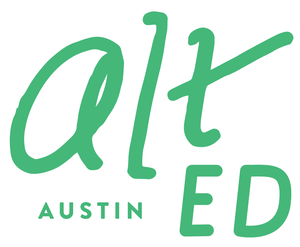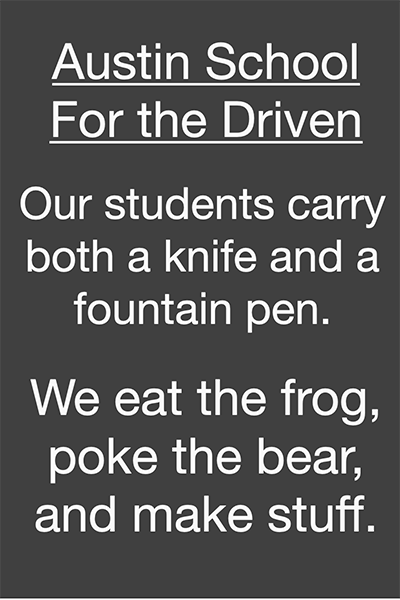Summer engagement ideas for teens
/Esha Clearfield, M.A. and M.P.Aff., is the founder and president of Enriched Family in Austin. This local business provides parents with the information, tools, and systems they need to organize their families and thrive. Drawing on her expertise in research, project management, and family organization, Esha helps busy parents with a wide variety of practical, comprehensive family supports and solutions, particularly family resource research (including camps, enrichment activities, childcare and schools, college comparisons and help managing the college application process, and more!) as well as personal, family, and small business organization services (organizing spaces and developing organization systems). We invited Esha to deploy her considerable research skills to the topic of summer engagement opportunities for teens and share her best ideas here. Thanks, Esha!
In my work with families, I often hear how difficult it is for parents to ensure that their teenagers are engaged over the summer break. Many parents have pointed out that it is hard to find camps whose programming is tailored to this age group, and often teens think of camps as being for “little kids” and are therefore resistant to attending. In this brief article, I focus on several local summer teen engagement resources, including camps that offer Counselor-in-Training (CIT) programs, as well as suggestions for volunteer, internship, and job opportunities.
Photo by Liam Macleod on Unsplash
Camp Counselor-in-Training (CIT) Programs
Many camps offer CIT programs—a great opportunity for teens to develop leadership skills and receive training as camp counselors. These programs are typically low-cost and fun, and they look great on a resume or college application. Here are a few Austin opportunities:
The Austin Nature & Science Center CIT program prepares teens (ages 15–17) to assist adult camp counselors in leading activities. There is a one-day training that equips CITs with the skills to become outstanding leaders by covering such topics as safety, child development, games, and songs. This popular program helps teenagers develop a sense of responsibility while increasing self-confidence. Participants can register for a maximum of 2 CIT camp sessions (each session is two weeks long: M–F, 8am–5pm). There are currently spots in the 6/24–7/5 & 8/5–8/16 sessions (the other June and July sessions are on a wait list). The cost of each two-week session is $198 for Austin residents. Register on the Austin Nature & Science Center website here.
The Austin Sunshine Camps CIT program is available to 15–18-year-olds who meet the qualifications (live in Travis, Williamson, Hays, Caldwell, or Bastrop county and qualify for the school free or reduced lunch program or the Supplemental Nutrition Assistance Program [SNAP] or are in foster care), demonstrate the ability to become a leader in their community, and are interested in becoming a camp counselor when they turn 18. There is no cost for the CIT program. Email programs@sunshinecamps.org for more information.
The Thinkery CIT program is available to teenagers (ages 13–18) who will work closely with Thinkery staff mentors to lead fun, STEAM (Science, Technology, Engineering, Arts, and Math)–based activities in Thinkery summer camps. Individual goals are set to ensure each participant develops new skills and gains valuable work experience that is transferable to future academic and career endeavors. If selected, applicants must commit to attending a series of training sessions. All selected applicants must agree to one week of the mandatory training dates and a minimum of 2 weeks of CIT camp support hours. Application is here. Deadline is May 1. There is a $10 program fee.
Photo by Rawpixel.com on Pexels
Volunteer Opportunities
A number of Austin organizations that focus on connecting youth to local nonprofits are in need of volunteers. Included below are a couple of examples:
Generation SERVE, whose mission is to “engage children in volunteerism and empower them to make a difference in their communities,” offers a summer Youth Leadership Program for middle and high school students. Teens selected for the program are trained in group facilitation, communication, problem solving, nonprofits, and fundraising. Teens then put this learning into action by leading or co-leading Generation SERVE’s Family Volunteering Activities and designing service projects to benefit the community. The fee for this program is $170–$200. For additional information and to apply for the program, click here. The application deadline is April 12.
If your teen is interested in summer volunteering but cannot commit to the Youth Leadership Program, Generation SERVE also offers one-time volunteer opportunities for teens in 6th–12th grades in the form of Teen Service Days, during which teens volunteer alongside their peers without a parent or guardian. These events give teens experience with volunteer projects in support of many different nonprofit organizations and community needs. Details and registration information can be found here.
Austin Habitat for Humanity also offers a variety of Youth Volunteer Opportunities, including painting, landscaping, planting trees, construction, home repair, and more, all depending on the age of the teen. Click here for information.
Other Volunteer/Internship Opportunities
Summer is a great time for teens to participate in formal or informal internships matched to their interests. For example, if your teen is interested in art, they could look into volunteer or internship opportunities at local art galleries. If your teen is interested in medicine and health, many hospitals have junior volunteer programs or summer volunteer programs for teens, ages 15–18. In addition, the City of Austin has a variety of Youth Volunteer, Internship, and Employment Opportunities they could explore here.
Job/Entrepreneurship Opportunities
Why not encourage your teen to explore some entrepreneurship activities over the summer? They could build and brand their own babysitting, lawn mowing/lawn care, dog sitting/walking, or odd jobs business. Or perhaps they could find a part-time or full-time job, depending on their other summer responsibilities.
Happy summer!
Esha Clearfield
Enriched Family



























